

MOVING PICTURES
On New Years Day, Jim Brandenburg, one of my favorite nature photographers, and film director Laurent Joffrion launched a video journal, posting a short video of the midwestern wilderness every day for the entire year. Nature 365 http://nature365.tv/ is the result of an accumulation of video clips Brandenburg shot while photographing with DSLR cameras over the past seven years. Brandenburg admits he had no project or idea in mind for them while making them. I love watching these short videos and find them very inspirational, and would encourage anyone who enjoys nature and photography to check them out. I have to confess though, that I have resisted getting into into video for the most part.
Toward the end of my time as a newspaper photographer, for certain assignments there was a push to have us shoot and produce short videos for web viewing, in addition to shooting still pictures for the paper. I always saw this as a "splitting the baby" approach because it didn't allow you to do either job as well as it could be done. In fact, I thought the videos were usually pretty poor quality. It also involved the cumbersome process of carrying two sets of gear and switching back and forth between cameras and digital video equipment. There were times, though, when a video just captured the story better than any still photos could. Sound and motion often reveal far more than a still image and written words can. Now that many DSLR cameras also capture HD video of amazing quality, many creative still photographers have adopted the new technology to produce amazing videos and even full length films. DSLR cameras are better suited to producing cinematic quality video than the lower end digital video equipment we were using.
This winter, inspired by the Nature 365 project, I spontaneously decided to shoot video of a fast moving snow squall crossing the Connecticut River. I made a 90-second video using iMovie that I think captures the feel of the dramatic weather visually, but the sound quality is so poor that it's unusable. My camera's built-in microphone is very limited and proper audio recording suffers without the use of an external video microphone. Since I don't shoot video that often, it seemed superfluous to carry one around with me.
Since making the squall video I have occasionally shot video clips of other situations I was photographing, without really having any idea what to do with them either. Again, they usually suffer from bad audio. Another sound issue that I have encountered is that it's really difficult to record nature in Connecticut for any length of time without some type of man-made noise in the background. Passing traffic, distant power equipment, speed boats on the water or planes flying overhead, some distracting sound can be heard in many of my video clips, even in the deepest woods. This shows how few truly wild places there are in the state, and I think I will appreciate the quiet of true wilderness much more now, if I ever get there again.
This spring I was fortunate to find a Barred Owl nest near my home that I was able to photograph several times over a couple of weeks. It involved a lot of patience, standing still and waiting for something to happen. After getting some still photos, I decided to start shooting video clips of the chicks in action and the adults when they were present. With the camera mounted on a tripod and trained on the nest, alternating between video and still photography was pretty convenient, just a matter of flipping the switch, but the situation didn't allow me to move around much and get different angles to vary the perspective. Using iMovie, I made a basic four-minute video to document the nesting owls. I did not put much into the production of the video, but there are some scenes that just don't translate as well in the still photos I shot. So, here are my moving pictures. Hopefully some day they might end up in something that approaches the beauty of Nature 365. At least it's a start.

P.S. - I reduced the image quality of the original HD files since they take so much time to upload. iMovie is a pretty basic tool compared to the Final Cut software which I used for video editing at the newspaper. If anyone has any suggestions on how to improve the editing and especially the audio in iMovie, please let me know, and definitely check out Nature 365.
THE HOLY GRAIL
Having worked most of my adult life as a photographer, I tend to treat wildlife photography like a job (even though the pay stinks) . Of course, if it was a job it would be one that I really enjoy, but what I mean is that I set goals and try to assign myself projects to work on. Yes, nature is unpredictable and I try to look out for any opportunities that may just pop up, but I also pick specific targets that I try to work on.
This self-assignment approach started when I rekindled my wildlife photography after a six-year hiatus. I was looking through my old slides and saw that I didn't have any good screech owl photos. I was disappointed to have nothing on such a common owl, so I made it my mission to find them. I started looking in suitable habitat, listening for them at night and checking just about every tree hole I walked or drove past. At first I was frustrated and had a fatalistic attitude that I wouldn't ever find something that I was looking so hard for. The breakthrough came after a few months. I was on my way home from work and drove past a tree with a couple holes in it that I'd passed a hundred times before. It was almost dark, but this time I noticed that one of the holes wasn't empty. I backed up and took a few shots out my car window in the marginal light. A few days later, I returned in slightly better light and got a few more shots from my car, since it was a on a busy road with no place to park nearby (I realize that I may not have been the safest driver during this period). The owl did not stay in that spot very long, but a short while later I found another "screech" in a tree on the side of the park road. This one was much better for photography. Over the next several months, I found two more. The flood gates had opened and I soon had hundreds of screech owl photos.
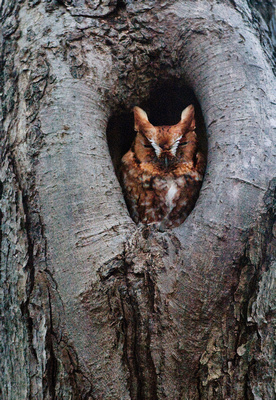 E SCREECH OWL 08-02-1521232OLD LYME, CT Eastern Screech Owl (Otus asio) red phase.
E SCREECH OWL 08-02-1521232OLD LYME, CT Eastern Screech Owl (Otus asio) red phase.
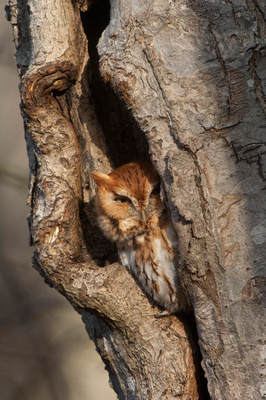 E SCREECH OWL 08-02-1621312NIANTIC, CT Eastern Screech Owl (Otus asio) red phase.
E SCREECH OWL 08-02-1621312NIANTIC, CT Eastern Screech Owl (Otus asio) red phase.
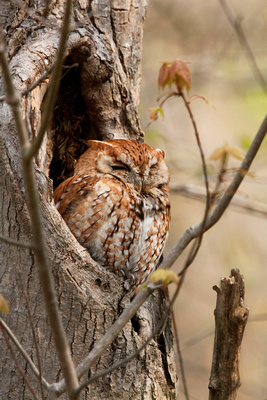 E SCREECH OWL 10-05-0122525LYME , CT Eastern Screech Owl (Otus asio).
E SCREECH OWL 10-05-0122525LYME , CT Eastern Screech Owl (Otus asio).
Full of confidence that my new approach was foolproof, my next project was to photograph a Great Horned Owl nest. Presto, like magic, two appeared before me. I was on a roll, so logically my next assignment, in keeping with the owl theme, was to find a Barred Owl nest. That's where the wheels ground to a screeching halt, and just fell off altogether. For the past four springs I have been looking for a Barred Owl nest without success. There were a couple close calls, where I'd heard and seen a pair repeatedly in the same location, and was sure they were nesting there. I just couldn't find where. At first it was just frustrating, then as the hours were consumed fruitlessly, it became a slight obsession. As years passed without finding one it became my nemesis, my curse, it became my Holy Grail.
This spring the curse was finally broken, and like the 2004 Boston Red Sox, it happened in the unlikeliest way. I had very little luck finding any nests this spring, and it was getting late in the season. On a drizzly morning I went hiking in a spot I had not been for a couple years carrying only my binoculars, hoping to scout out possible photo opportunities. The trail took me up to a hilltop, and through a hole in the leaves I saw a narrow cavity in a large oak tree. I immediately thought, "Wow, that looks like a perfect nest hole." I trained my binoculars on it, but didn't see anything inside. The hole was about 30 feet up in the tree, which was growing at the bottom of the hill, so from the hilltop it was right at eye level. As if I was willing it to be an owl nest, I stared into the hole with my binoculars for a minute or two, but nothing appeared. I continued down the hill and a hundred yards down the trail when a squirrel suddenly chattered in alarm, clinging to a tree trunk with its tail twitching. The woods erupted with sharp thrush calls, vireo rattles and titmouse whines. Was it me that was causing all the commotion? I stopped walking and scanned the woods for whatever it was that was alarming all the woodland creatures. I stood there for several minutes but didn't see anything. The rain started to pick up and the chatter died down, so I started to walking back the way I came. Something big and brown flew over my head, and down the trail where it just disappeared. I stopped back at the top of the hill and stared back into the tree cavity for a bit and a face appeared.
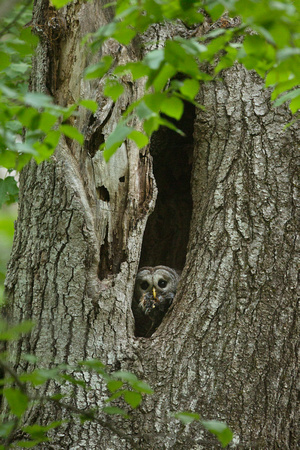 BARRED OWL 15-05-2883090Barred Owl (Strix varia) at tree cavity nest in Connecticut forest.
BARRED OWL 15-05-2883090Barred Owl (Strix varia) at tree cavity nest in Connecticut forest. A Barred Owl stared out at me, then squeezed out of the hole and flew off. The Holy Grail was finally within reach, but I didn't have my camera with me and had no pictures yet. I returned later that evening and waited under a camouflage blind to see if I could get some pictures, but no owls appeared. A few days later I tried again in the morning, but saw nothing. Was this going to turn out badly? I had the same nervous feeling when the Red Sox came back from 0-3 down to beat the Yankees in the 2004 ALCS. What if they lost to the Cardinals in the World Series? I would be the cruelest failure of all time.
A Barred Owl stared out at me, then squeezed out of the hole and flew off. The Holy Grail was finally within reach, but I didn't have my camera with me and had no pictures yet. I returned later that evening and waited under a camouflage blind to see if I could get some pictures, but no owls appeared. A few days later I tried again in the morning, but saw nothing. Was this going to turn out badly? I had the same nervous feeling when the Red Sox came back from 0-3 down to beat the Yankees in the 2004 ALCS. What if they lost to the Cardinals in the World Series? I would be the cruelest failure of all time.
Until I had a picture, I couldn't relax. So I waited, standing under a bag blind for hours. Four hours passed and I started getting hungry. Six hours, still nothing, my back and legs were starting to ache. Eight hours, nothing, I think I was starting to hallucinate. Finally, late in the afternoon, I heard a faint two-syllable call. Then, again, a little closer. At the bottom of the tree cavity, the top of a fuzzy white head appeared. A minute later an adult owl landed on a branch just above the nest. With my lens trained on the hole, I didn't dare move. The owl dropped down into the nest and reappeared with the remains of a bird of some type. With the camera on silent drive, I managed about five or six shots before the owl flew off. Again, the light was pretty low, and the shutter settings were marginal. I checked the pictures in the LCD and there was hope. I drove home and immediately downloaded them and checked them on the computer. At last, the Holy Grail was in my grasp.
Over the next two weeks, I visited several times and got to watch the owl chicks grow and make their way out of the tree cavity. I got to see the adults roosting in the nearby woods, and bring food to the nest, usually once during the day. Occasionally other hikers walked by on the trail while I was there. I was dressed in a mesh bug suit and hiding under a camouflage cloth just off the trail and realized this could be seen by some (or most) as a bit strange and even threatening. Most didn't even notice me, and to the few that did, I explained that I was photographing birds, without revealing the specifics. The owls knew when I was there, but I kept my distance and they seemed to tolerate my presence.
One of the highlights of my nest watch was seeing a chick climb out of the tree cavity for the first time. At first they could barely be seen in the bottom of the nest, but as they grew, they appeared more frequently and began flapping their wings inside the hole. One day, I was bored and waiting for something to happen. Suddenly, a downy white chick lurched into the bright light and, using its beak, pulled its way out onto the edge of the cavity. It was quite unsteady and I was petrified it would fall out of the nest, but it propped itself up and stared out into the woods for a while. Another highlight was seeing a chick studying a small flock of songbirds that were flitting around it in alarm as it perched in the opening. It was also a treat to see the adults bringing food to the nest and watching the nest almost invisibly from nearby.
As they grew, I wondered how the chicks would leave the nest since it was up about 30 feet, and there were no branches below the cavity. I arrived one day and found one chick out on the trunk of the tree where it forked, about four feet above the nest cavity. The other was perched in the opening of the nest hole and was trying to walk its way up the tree, but could not make it all the way. The chick above the nest was climbing up and down the trunk and hopping from one fork to the other. The adult owls were close by and seemed more nervous this time. I took some pictures and video and decided to leave after a while, wondering if it was the last time I'd see them.
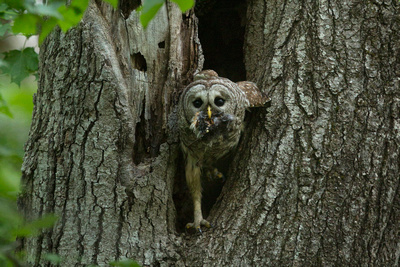 Barred Owl (Strix varia) nest in Connecticut forest.
Barred Owl (Strix varia) nest in Connecticut forest.
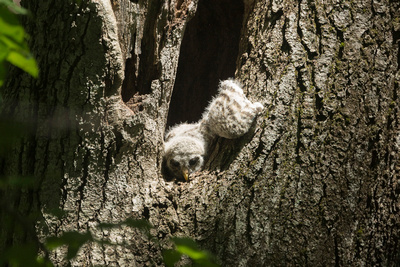 Barred Owl (Strix varia) nest in Connecticut forest.
Barred Owl (Strix varia) nest in Connecticut forest.
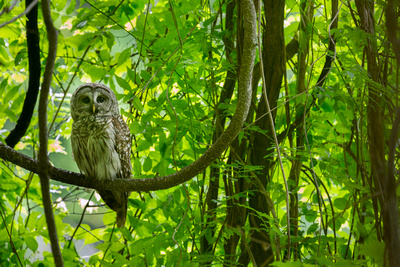 BARRED OWL 15-06-0983838Barred Owl (Strix varia) roosting near nest in Connecticut forest.
BARRED OWL 15-06-0983838Barred Owl (Strix varia) roosting near nest in Connecticut forest.
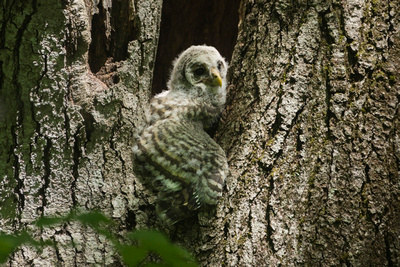 Barred Owl (Strix varia) nest in Connecticut forest.
Barred Owl (Strix varia) nest in Connecticut forest.
 BARRED OWL 15-06-0983804Barred Owl (Strix varia) adult near nest in Connecticut forest.
BARRED OWL 15-06-0983804Barred Owl (Strix varia) adult near nest in Connecticut forest.
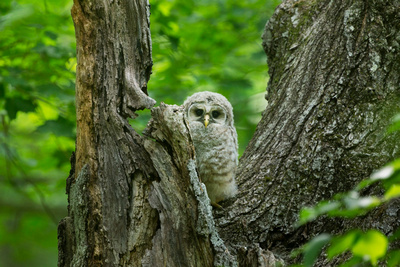 BARRED OWL 15-06-1184036Barred Owl (Strix varia) chick branching from tree cavity nest in Connecticut forest.
BARRED OWL 15-06-1184036Barred Owl (Strix varia) chick branching from tree cavity nest in Connecticut forest.
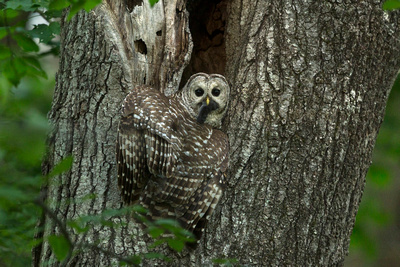 Barred Owl (Strix varia) nest in Connecticut forest.
Barred Owl (Strix varia) nest in Connecticut forest.
 BARRED OWL 15-06-1184099Barred Owl (Strix varia) chick branching from tree cavity nest in Connecticut forest.
BARRED OWL 15-06-1184099Barred Owl (Strix varia) chick branching from tree cavity nest in Connecticut forest.
When I returned late the next day, I looked from a distance with my binoculars, but there was no sign of the chicks in the tree. As I started to walk down the trail toward the spot where I had been photographing from, one of the adults flew out and landed in a tree just in front of me, staring down at me. The chicks had likely branched out of the nest, still unable to fly, and were most vulnerable at this time. I decided to leave well enough alone, whispered a quiet thank you under my breath, and retreated back to my car. The Holy Grail was finally attained, I was grateful for the time I had with them. With my faith in the self-assignment approach restored, there are plenty of new Holy Grails on my list to find now.
OUTDOOR EDUCATION
After such a nasty winter, I really couldn't wait for spring to arrive this year, but this spring brought new, unpleasant surprises. My photography took a back seat, and when there was time for it, it wasn't very productive or enjoyable, especially early on. The unusually cold weather continued into March and April and seemed to throw off the rhythm and timing of spring's changes. I always look forward to my first sighting of an Osprey returning to Niantic in early March as the true signal that winter is on the way out, but this year it was closer to early April. The runs of Alewife returning from the ocean to spawn in area streams and ponds usually begin shortly after the Osprey return, and are an important food source for them. I've learned that this can produce some great spring photo opportunities if you can find the Osprey that have found the fish, but this year it didn't quite work out for me. There were a few days when I saw a dozen or more Osprey circling and hovering above sections of the Bride Brook in Rocky Neck State Park where the fish were to be expected, but saw just a few dives and even fewer catches.
 OSPREY 15-04-1282263NIANTIC, CT Osprey (Pandion haliaetus) with Alewife catch.
OSPREY 15-04-1282263NIANTIC, CT Osprey (Pandion haliaetus) with Alewife catch.
There just didn't seem to be that many fish this year. I figured the cold spring had delayed the Alewife runs as it did the returning Osprey, or even worse, that the number of returning fish had declined sharply. Either way, it was a disappointment for me, and a problem for the Osprey, that were forced to look farther away for different types of fish. One Osprey I photographed in a courtship display near Rocky Neck actually had a trout in its talons.
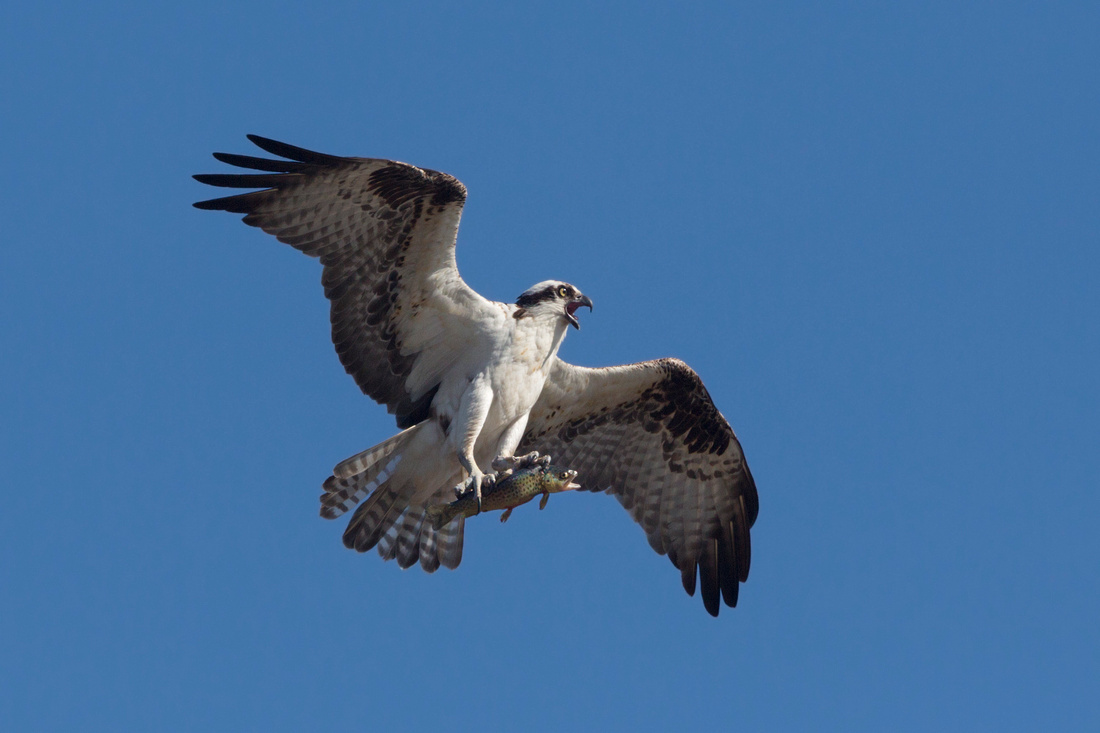 OSPREY 15-04-0181812BOLD LYME, CT Osprey (Pandion haliaetus) in courtship display with trout.
OSPREY 15-04-0181812BOLD LYME, CT Osprey (Pandion haliaetus) in courtship display with trout.
In mid-May I took an evening drive through Rocky Neck even though I've usually moved on to greener pastures (actually the woods) by then, and noticed a lot of gull activity near the bridges near the mouth of the Bride Brook. The park has usually quieted down a lot by then, so I was surprised to see so much commotion. I stopped to investigate, and saw the gulls circling and diving into the water, which was percolating with schools of fish. It was a month or so after the Alewife runs were expected, but could they have arrived this late?
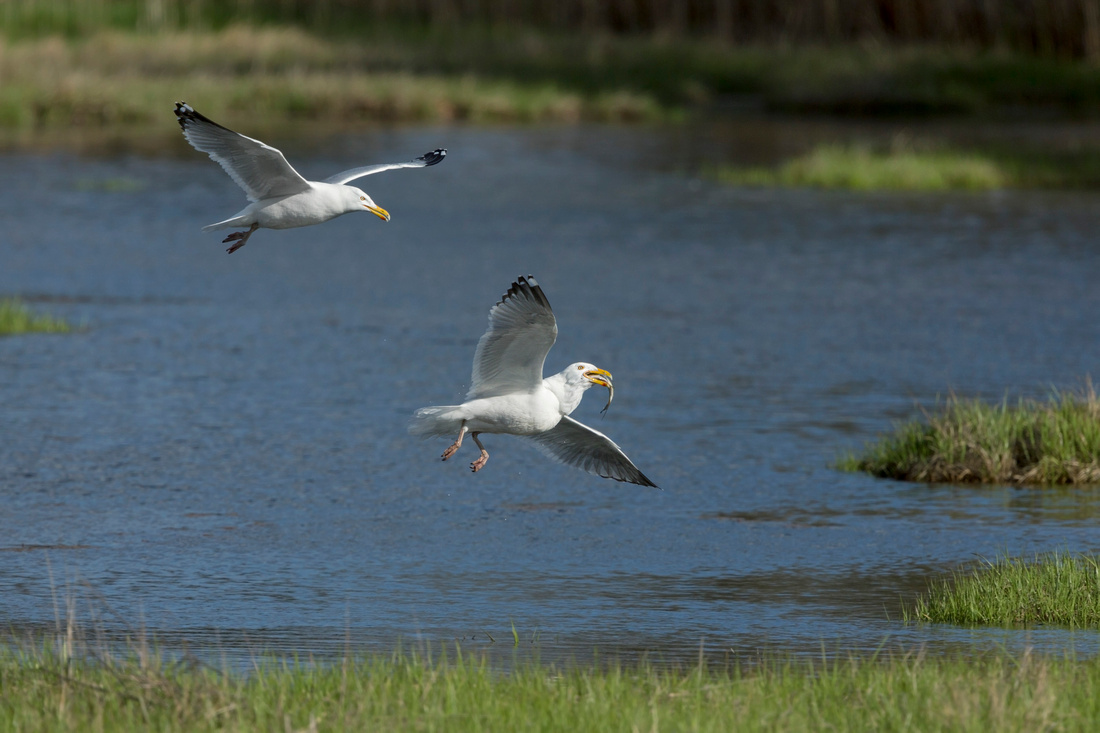 HERRING GULL 15-05-1382730NIANTIC, CT Herring Gull (Larus argentatus).
HERRING GULL 15-05-1382730NIANTIC, CT Herring Gull (Larus argentatus).
The next morning I went back and found the same situation. I could see the large schools of Alewife swimming between the two bridges, sometimes right below me. I had never seen the fish like that before, and was surprised to see them swimming back and forth up and downstream during the day. Several years ago, while working on a newspaper story about the DEEP's efforts to restore the dwindling Alewife runs, I learned that the fish swim upstream at night, so this seemed odd.
 ALEWIFE 15-05-1482809BNIANTIC, CT Alewife (Alosa pseudoharengus) is an anadromous species of herring that returns from the ocean each spring to spawn in fresh water. Shortly after spawning they return to the ocean. These fish were photographed in a shallow salt marsh tidal creek on there return run to the ocean.
ALEWIFE 15-05-1482809BNIANTIC, CT Alewife (Alosa pseudoharengus) is an anadromous species of herring that returns from the ocean each spring to spawn in fresh water. Shortly after spawning they return to the ocean. These fish were photographed in a shallow salt marsh tidal creek on there return run to the ocean. Even though the water was "boiling" with fish, only one or two Osprey were in the area to fish them, most had established their nest sites and fishing grounds by then. Even the gulls were not as active as the night before, perhaps they had their fill already? One creature, however, was having a field day with the abundant supply of Alewife. A mink repeatedly slunk to the edge of the brook, and slid into the water.
Even though the water was "boiling" with fish, only one or two Osprey were in the area to fish them, most had established their nest sites and fishing grounds by then. Even the gulls were not as active as the night before, perhaps they had their fill already? One creature, however, was having a field day with the abundant supply of Alewife. A mink repeatedly slunk to the edge of the brook, and slid into the water.
 AMERICAN MINK 15-05-1582618NIANTIC, CT American Mink (Neovison vison).
AMERICAN MINK 15-05-1582618NIANTIC, CT American Mink (Neovison vison). A short while later it would climb out and bound along the same route through the salt marsh with its impressive catch, to a spot at the edge of the adjacent woods. The fish looked to be close to half the size of the mink itself. I witnessed this five or six times within the span of a couple hours, so it seems unlikely that it could be eating the fish on its own, and must have had a family to feed in a hidden den. One two occasions the mink had an eel, equally impressive in relative size, instead of an Alewife.
A short while later it would climb out and bound along the same route through the salt marsh with its impressive catch, to a spot at the edge of the adjacent woods. The fish looked to be close to half the size of the mink itself. I witnessed this five or six times within the span of a couple hours, so it seems unlikely that it could be eating the fish on its own, and must have had a family to feed in a hidden den. One two occasions the mink had an eel, equally impressive in relative size, instead of an Alewife.
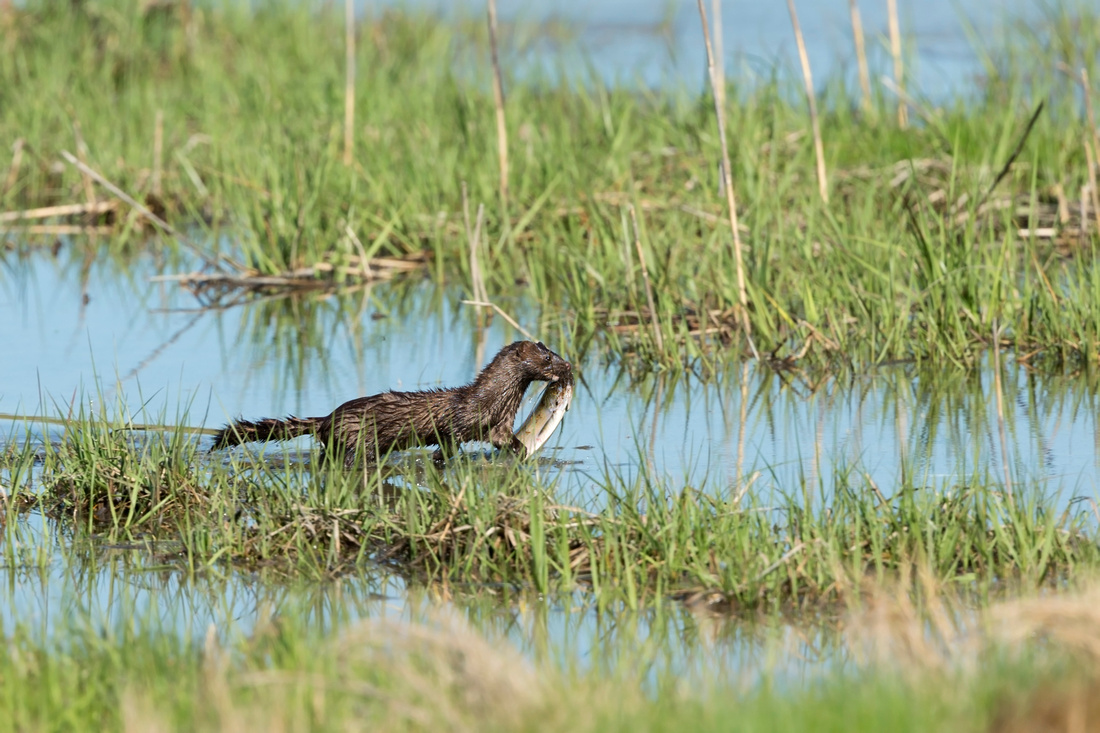 AMERICAN MINK 15-05-1582625NIANTIC, CT American Mink (Neovison vison).
AMERICAN MINK 15-05-1582625NIANTIC, CT American Mink (Neovison vison). As the light got too harsh for photography, I walked back to my car and a man in a pick-up truck rolled his window down and asked what I was photographing. "Birds", I said, not wanting to get too specific. He replied that I should go the the beach at the mouth of the brook because the gulls were having a field day with river herring. We struck up a conversation and I found out he worked for the DEEP's anadromous fish program and was monitoring the Alewife in the Bride Brook. It turned out that the fish were not entering the brook to spawn, but actually on their way back out to the ocean. They had become trapped by the sandbar that built up in front of the restored channel the DEEP created at the mouth of the brook and could only exit the brook at the highest tide. This was the reason they were swimming back and forth during the day. I also learned that the herring did return at about the same time they usually do and the numbers were actually pretty good this year.
As the light got too harsh for photography, I walked back to my car and a man in a pick-up truck rolled his window down and asked what I was photographing. "Birds", I said, not wanting to get too specific. He replied that I should go the the beach at the mouth of the brook because the gulls were having a field day with river herring. We struck up a conversation and I found out he worked for the DEEP's anadromous fish program and was monitoring the Alewife in the Bride Brook. It turned out that the fish were not entering the brook to spawn, but actually on their way back out to the ocean. They had become trapped by the sandbar that built up in front of the restored channel the DEEP created at the mouth of the brook and could only exit the brook at the highest tide. This was the reason they were swimming back and forth during the day. I also learned that the herring did return at about the same time they usually do and the numbers were actually pretty good this year.
 ROCKY NECK 15-05-1583417NIANTIC, CT Alewife restoration efforts at the mouth of the Bride Brook at Rocky Neck State Park.
ROCKY NECK 15-05-1583417NIANTIC, CT Alewife restoration efforts at the mouth of the Bride Brook at Rocky Neck State Park.
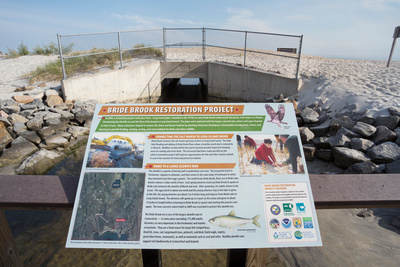 ROCKY NECK 15-05-1583433NIANTIC, CT Alewife restoration efforts at the mouth of the Bride Brook at Rocky Neck State Park.
ROCKY NECK 15-05-1583433NIANTIC, CT Alewife restoration efforts at the mouth of the Bride Brook at Rocky Neck State Park.
One of the things I like most about photographing wildlife is that it provides a first hand opportunity to observe and learn about the things I take pictures of. What I learn can then be helpful in finding new photo opportunities in the future. Instead of getting the herring on the way in, this year I got them on the way out. I haven't ever seen the Alewife returning to the sea in such a dramatic way, and may never again, but now I'll be looking out for it if it happens.
GROUNDHOG DAY - ETHICS IN WILDLIFE PHOTOGRAPHY PART @$%^#*
In the past few days I've seen links and comments about the article in the May 2015 edition of Audubon Magazine called "Too Close for Comfort", about the ethics of wildlife photographers. The article details several examples of photographers disturbing nesting birds in Florida and the conflicts that are arising from their behavior. This is a tired old subject that I have dealt with for years and written about a few times in the past, (here is a link to a blog I wrote two years ago, on the occasion of another blow up: http://bobmacdonnell.zenfolio.com/blog/2013/3/about-photography), but I'll add my two cents again, against my better judgement.
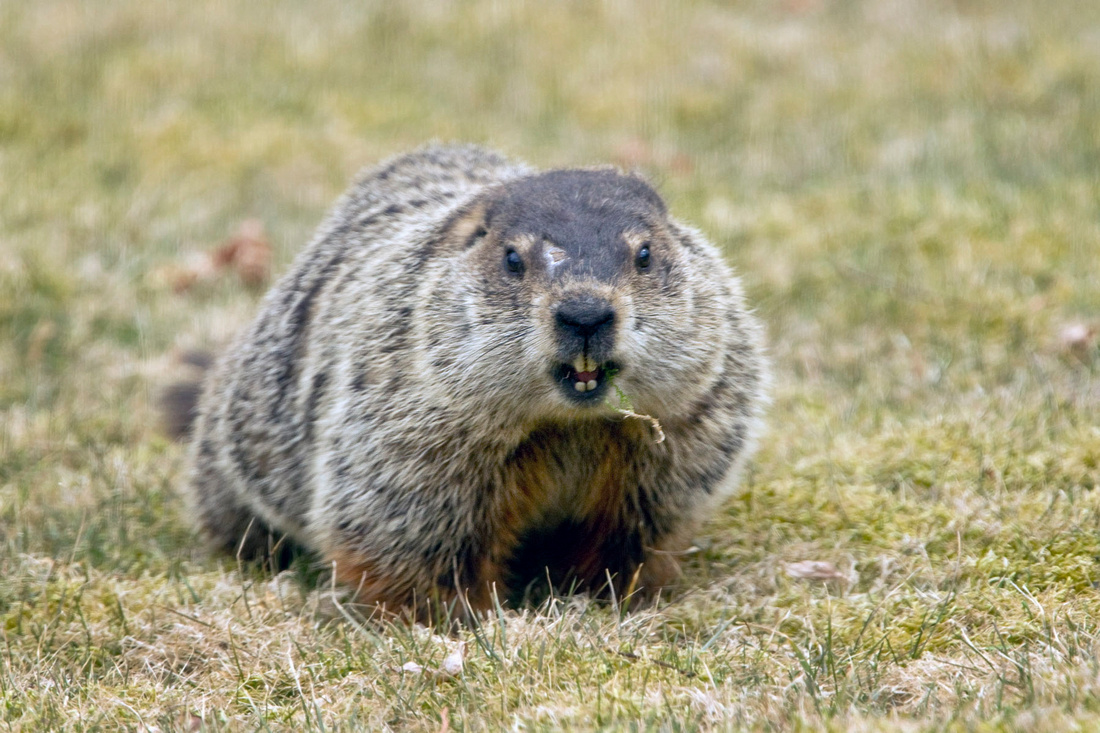
 The Audubon article begins with a Florida photographer who was prosecuted for violating the Endangered Species Act by getting too close to a Snail Kite nest on several occasions, ignoring a sign posted to keep viewers a certain distance away. The photographer in question was leading a commercial tour for other photographers, taking them by boat to what I assume is a pretty remote location. While I don't know him personally, I am familiar with his work and he is very good at what he does, and has built his tour business on those talents. Of course that doesn't give him the right to violate the law, and it appears that his case is pretty black and white. The more common problems are the gray areas where nobody sees eye to eye.
The Audubon article begins with a Florida photographer who was prosecuted for violating the Endangered Species Act by getting too close to a Snail Kite nest on several occasions, ignoring a sign posted to keep viewers a certain distance away. The photographer in question was leading a commercial tour for other photographers, taking them by boat to what I assume is a pretty remote location. While I don't know him personally, I am familiar with his work and he is very good at what he does, and has built his tour business on those talents. Of course that doesn't give him the right to violate the law, and it appears that his case is pretty black and white. The more common problems are the gray areas where nobody sees eye to eye.
Experienced wildlife photographers know that having a good knowledge of their subjects is one of the most important tools they can possess to get good pictures. Many started out as biologists or naturalists, and some may know as much about the creatures they photograph as anyone, including birders or researchers. While hard-earned experience and knowledge is helpful, it can sometimes lead to hubris, and allow a photographer to feel it's okay to push a subject to get the desired picture. With some newer photographers, a lack of experience may cause them to cross the line without even knowing it, and with some there is just a lack of concern for their subjects. The question is what are the limits and who determines them.
Working as a newspaper photographer, I was occasionally able to gain access to protected wildlife through my job and was able to get pictures that might not be accessible to everybody. I have tried to work with scientists and researchers both for access and for guidance on how to safely photograph certain subjects, but is it okay for a newspaper photographer or one shooting for National Geographic or Audubon to take certain pictures and not okay for another photographer?
As a photojournalist, most of my work was to illustrate news stories with informative and interesting pictures. My approach to wildlife photography is similar, and I try to portray creatures in a way that tells something about their lives, what they eat, where they live ....etc. It's for that reason that I like photographing nesting birds, because it is such an important part of their lives. I know it's a sensitive subject, and there are many wildlife photographers will never photograph birds on the nest and bristle when others do. I wrote a blog post about photographing nesting birds a long time ago, which remains an unpublished draft because other than me, who cares what I think?. I'm not trying to encourage anyone else to photograph nesting birds, just explain how and why I do.
One of my earliest nest encounters was in the 1990's with a Yellow Warbler which I found just off a path in a popular park. I watched the nest from a distance for a couple weeks (I knew not to photograph until the chicks hatched because there would be a greater chance that they could abandon the site). I told a few other local birders who were very helpful and friendly to me about the nest and when the chicks hatched, I waited through the weekend when the park was busy and went early Monday morning to get my first pictures. When I arrived at the nest, there was a photo blind set up in front of it, so I walked around the rest of the park for a while and returned again but the blind was still there. I set my gear down about 50 yards away and waited until the photographer eventually got out and started to yell at me. He gave me some B.S. story about how he had been photographing the nest for weeks and had sold several pictures from it already, but I found out he was on a bird walk that weekend led by one of the birders I'd told about the nest. I came back later and found that he'd cut some branches below the nest exposing the bright nest fibers and making the nest much more conspicuous. The birds were okay, but I learned an important lesson that has stuck with me since. Never tell anyone else about a found nest.
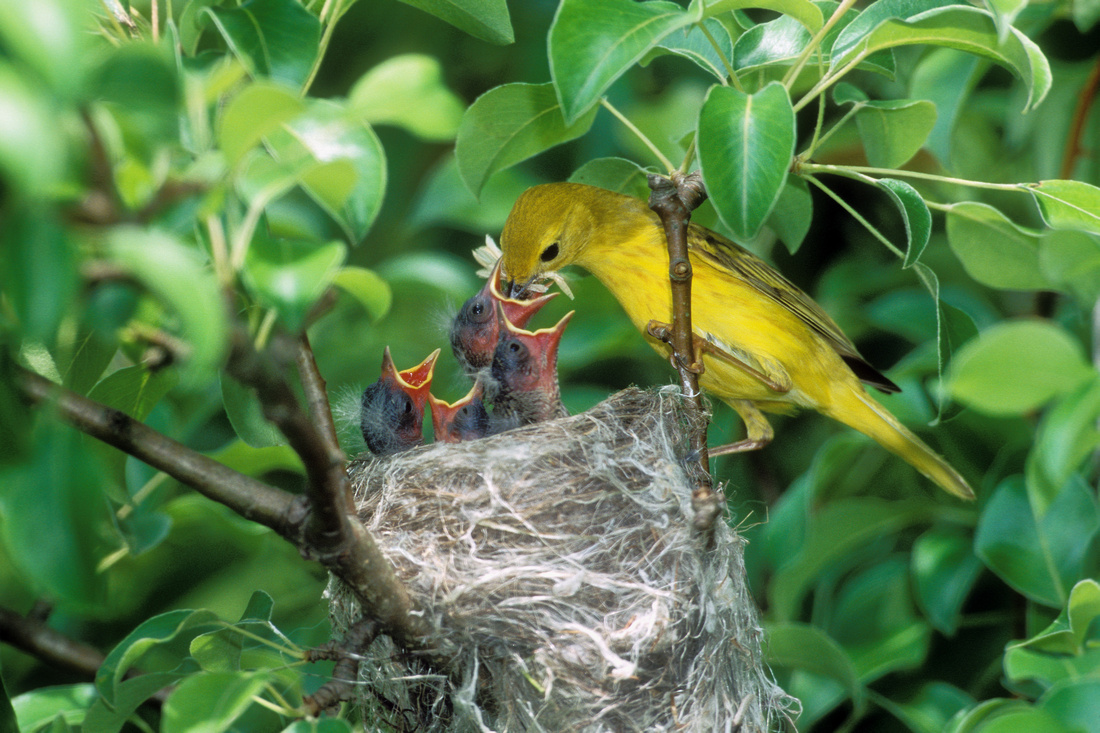

The Audubon article talks about the danger of photographers leading groups of people to nesting areas. A year after my Yellow Warbler episode, I went on a group tour to Churchill led by professional wildlife photographers. There were six clients and two guides and we photographed nesting birds, mostly shorebirds, on the open tundra. It was a productive trip, but there were a few things I was uncomfortable with. I felt uneasy being in a group of large men shooting small birds from a few yards away, even though the bird seemed to tolerate our presence.

 On top of that, there were some in the group who wanted to get closer than others were comfortable with, causing the birds obvious stress. I was excited to photograph these beautiful birds in breeding plumage, sitting on their nest, but felt bad when they went through their distraction displays when we first approached or when someone moved too close.
On top of that, there were some in the group who wanted to get closer than others were comfortable with, causing the birds obvious stress. I was excited to photograph these beautiful birds in breeding plumage, sitting on their nest, but felt bad when they went through their distraction displays when we first approached or when someone moved too close.
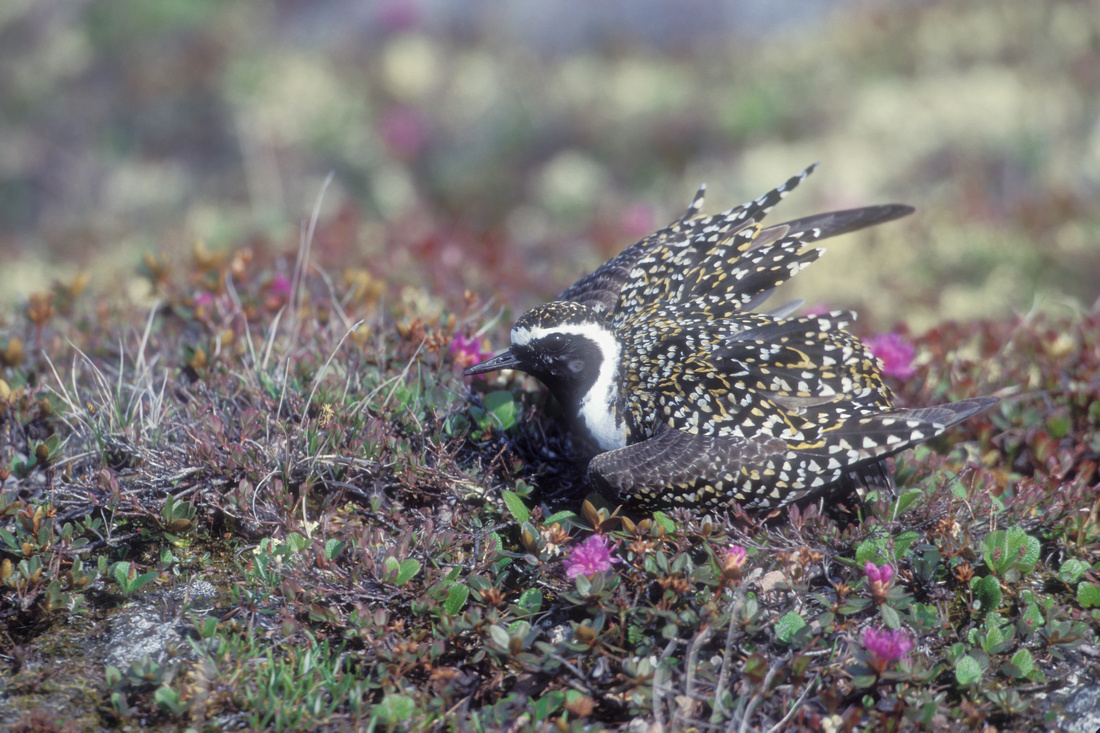
 One day we found a beautiful Pacific Loon, one of my main target species for the trip, on its nest and were getting incredible full frame pictures in great light.
One day we found a beautiful Pacific Loon, one of my main target species for the trip, on its nest and were getting incredible full frame pictures in great light.
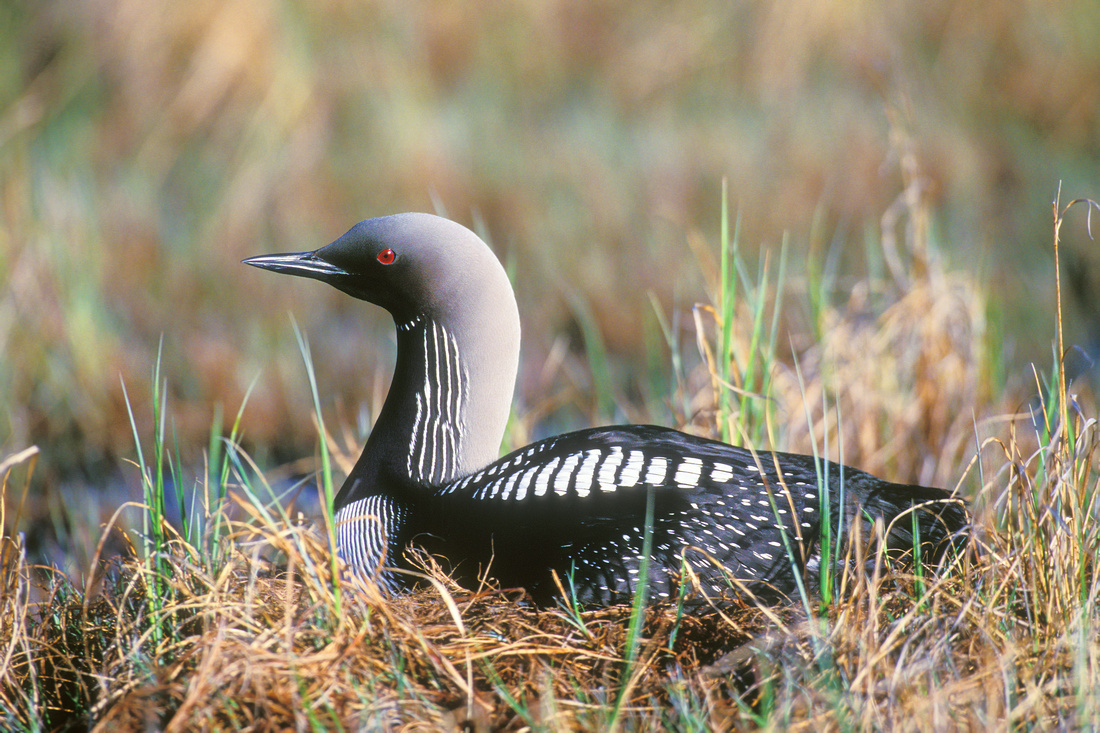
 Some in our group kept creeping closer, until the bird finally sprang from the nest with a loud sound I can't begin to describe and started flailing and splashing in the pond nearby. All our cameras were clicking away for the short while this occurred, and the pictures are pretty wild, but I had a sinking feeling after it happened. I learned later that this was an alarm display and have seen published pictures of other loons just like it. The captions usually describe a rival loon approaching or a predator flying overhead, but now that I know what it is I hope I don't see it again.
Some in our group kept creeping closer, until the bird finally sprang from the nest with a loud sound I can't begin to describe and started flailing and splashing in the pond nearby. All our cameras were clicking away for the short while this occurred, and the pictures are pretty wild, but I had a sinking feeling after it happened. I learned later that this was an alarm display and have seen published pictures of other loons just like it. The captions usually describe a rival loon approaching or a predator flying overhead, but now that I know what it is I hope I don't see it again.

 The biggest problem I had with the group dynamic turned out to be that I got basically the same shots as the rest of the group and that felt less satisfying to me. My goal at the time was to sell pictures for publication, but I don't think I ever sold any from the trip. The guides that led the tour and one or two of the clients had pictures from the trip published in books and articles about the location, but the market for those type of pictures was pretty much covered. Photographing with a group and getting the same or similar pictures as a bunch of other photographers was not only less satisfying, but it was also bad business. That was the first, last and only group photo tour I've been on.
The biggest problem I had with the group dynamic turned out to be that I got basically the same shots as the rest of the group and that felt less satisfying to me. My goal at the time was to sell pictures for publication, but I don't think I ever sold any from the trip. The guides that led the tour and one or two of the clients had pictures from the trip published in books and articles about the location, but the market for those type of pictures was pretty much covered. Photographing with a group and getting the same or similar pictures as a bunch of other photographers was not only less satisfying, but it was also bad business. That was the first, last and only group photo tour I've been on.
Earlier that year, my wife and I drove to Florida to visit her family and I talked her into stopping at the Venice Rookery so I could take some pictures. We arrived in the early morning darkness, and when the sun finally rose, I was underwhelmed by the tiny stand of mangroves in the small pond at the Venice municipal complex. Among the dozens of photographers there, I met two whose work I'd seen published and complimented them on it. The asked me where I was from and I told them I was visiting from Connecticut and was hoping to visit a few of the Florida birding hotspots and asked if they had any suggestions. What happened next shocked me, but they both got angry and said they were tired of outsiders coming in and photographing in their home territory and cutting into their stock business. Florida .... Vacationland ....? Turf is turf, and it was being defended.

 The situation today is almost the exact opposite. With the advent of digital photography it seems like everyone has a camera and the flood of new photographers has completely changed the landscape of all types of professional photography, wildlife photography included. Photographers who once made a living selling stock pictures to magazines and calendars found the overwhelming volume of new work and the diminishing number of outlets for it caused publication fees to plummet, crashing their business. Magazines like Audubon were always tough to break into, but even the smallest magazines now act like you are bothering them by trying to submit pictures you want to be paid for, and they pay accordingly . Photographers who once guarded their prime shooting spots figured out that they could make up for lost publishing income by leading tours for the hordes of newcomers to those same locations. Common sense dictates that probably doesn't benefit the creatures there.
The situation today is almost the exact opposite. With the advent of digital photography it seems like everyone has a camera and the flood of new photographers has completely changed the landscape of all types of professional photography, wildlife photography included. Photographers who once made a living selling stock pictures to magazines and calendars found the overwhelming volume of new work and the diminishing number of outlets for it caused publication fees to plummet, crashing their business. Magazines like Audubon were always tough to break into, but even the smallest magazines now act like you are bothering them by trying to submit pictures you want to be paid for, and they pay accordingly . Photographers who once guarded their prime shooting spots figured out that they could make up for lost publishing income by leading tours for the hordes of newcomers to those same locations. Common sense dictates that probably doesn't benefit the creatures there.
With so many more people photographing wildlife today, it's also harder to stand out or get noticed unless you have some really unique pictures and may be willing to push the limits with your subjects. In a way, magazines, including Audubon, may be indirectly contributing to the problems when their editors select the most unique and unusual pictures to publish. If that's what it takes to get noticed or published, there are always people who will do it, and others will follow their lead. Shooting wildlife up close or with a wide angle lens, or using remote cameras or camera traps are all growing trends in wildlife photography. On the same web page for the Audubon story documenting these ethical issues with wildlife photographers is a link to the 2015 Audubon Photo Contest winners. In the gallery of top 100 photos are examples of the same things they are decrying, including extreme close-ups, wide angle close-ups and pictures of birds at their nest. One of the contest judges is a photographer whose work I admire, but I've seen close-up wide angle pictures of nesting birds on the tundra that he's taken published in National Geographic.
I don't know exactly how any of those photographs were made, but surely some birders or naturalists would take issue with these photographers if they were there to witness it. I do know that if editors and judges use or select those kinds of pictures, more photographers will copy them. While working on a photo package about the Audubon Christmas Bird Count for the Hartford Courant, I showed some of my stock photos to my editor, and she selected a picture of a screech owl with its eyes wide open. I tied to talk her into picking a picture where the owl didn't look so alarmed and wasn't staring right at the camera, but she liked owl with its wide open, as most editors do. Is it any wonder then that photographers will whistle, squeak, squeal or do whatever they can to get an owl to open its eyes, regardless of how it affects the owl.
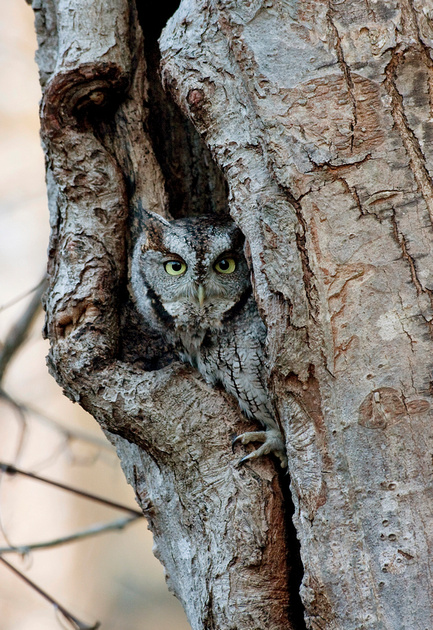



I've been trying more wide angle and remote camera techniques in recent years to get a different look than the long lens, shallow depth of field perspective so typical of most wildlife photography, including my own. Just as the wide angle shot from the Osprey nest I wrote about in my earlier blog post angered some, I'm sure there are many who would not approve of these recent efforts, not knowing how they were obtained. The Wood Thrush nest photo below was taken with a remote camera on a pole that reached nearly 10 feet over my head. I watched the bird from my car, from about about 40 yards away, for more than an hour before it left the nest, then jumped out with my contraption already set up and took about 20 pictures. The whole thing lasted around a minute and I returned to my car and the bird returned to the nest. I like the picture and I know it did not result in any harm to the birds, I saw the chicks fledged from the nest, but I'm sure this falls in the gray area for some and is completely out of bounds for others.
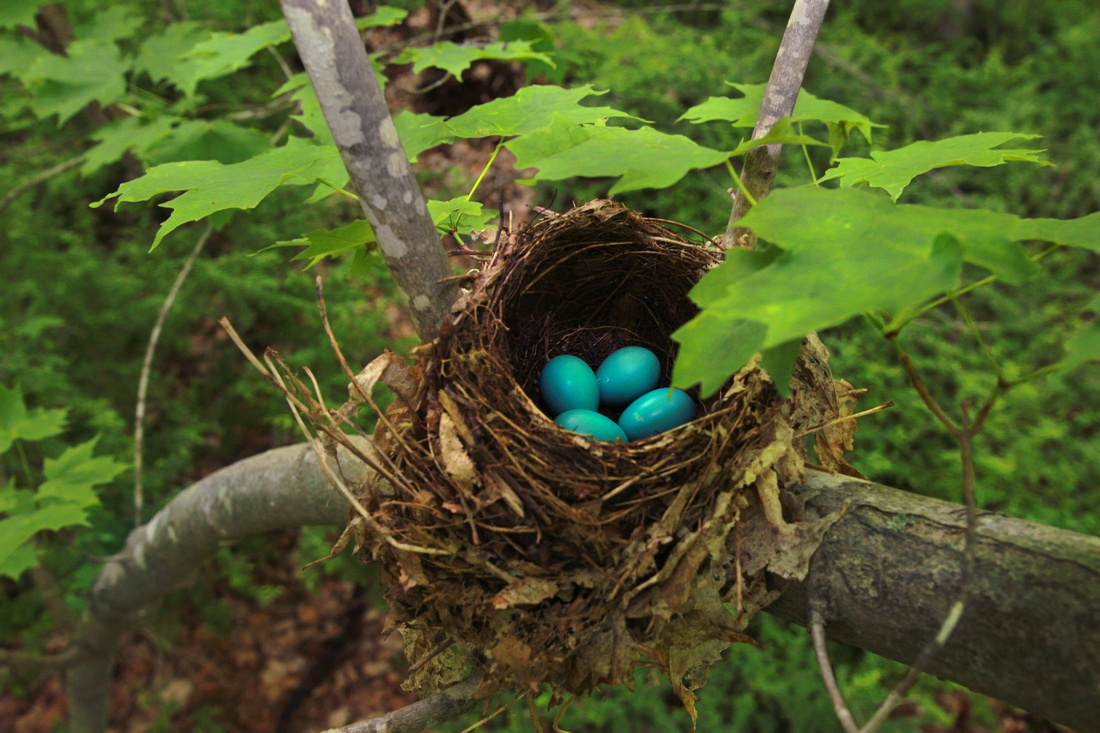

I took a philosophy course in college called Ethics. I was a biology major at the time and can't remember much of what the class was about, but I do remember that there didn't seem to be right or wrong answers, you had to subjectively reason your response. This wasn't easy to grasp for a science major. One of my favorite wildlife photography books is called "Vanishing Songbirds" by Eliot Porter. It contains dozens of beautifully lit, sharply detailed large format photos of many North American songbirds at their nest that were taken 40 or 50 years ago. The book was made in an effort to document the decline of the birds Porter was so passionate about and receives high praise, even today. I love the pictures and would like to emulate them, but by today's photography ethics, these pictures would be considered criminal evidence.
I spend lots of time in the woods each spring looking for nests and find a fair number. I never even try to photograph most of them because they are hard too even see. I have found Blue-winged Warbler and Common Yellowthroat nest sites, down to a square foot, but never seen an actual nest because I'd never part the dense clumps of vegetation they are buried in. Instead, I do the best I can to capture those kind of photos within my ethical standards. My chances are greatly limited, and the pictures are usually flawed by some distracting element I wont remove. The one picture I've taken that comes closest to those Elliot Porter pictures is one of a Worm-eating Warbler nest. I was parked in a pull-off area on a dirt road in the forest listening for songbirds with the windows down and saw the birds bringing nest material to the leaf covered hillside adjacent to my car. I was able to watch the progress of the nest for the next few weeks from my car, and eventually photograph it from an open window covered with mosquito netting. It's one of my favorite photographs because I was able to see right into the nest and into their world like I was a fly on the wall, the birds seemingly unaware of my presence, which made it so satisfying.

 In the nearly 30 years I've worked as a photographer, it has changed more dramatically than I could have imagined. New technology has made wildlife photography more accessible to many more people and the internet has made it much easier to learn how and where to find subjects. Photographers' work will evolve over time and some will shape and others follow the new styles and trends. Like most things these days, the trend is more extreme. The one thing that has not changed in that time is that wildlife photographers have come under fire for "endangering" their subjects. Game farms, baiting, getting too close, flash photography, group tours, owl roosts, Snowy Owls, Bald Eagle nests .... the list goes on and on. It's easy for someone with no interest in wildlife photography to say here's the line and you're wrong if you cross it. It's not that simple. Wildlife would be better off if there weren't six billion people on earth, too, but I don't see those people volunteering to check out. Right or wrong, black or white, or the dreaded gray areas, pushing the limits has always been a part of progress. I think photographers need to figure out when we have reached the line, beyond which we are harming our subjects, and hopefully we don't cross it.
In the nearly 30 years I've worked as a photographer, it has changed more dramatically than I could have imagined. New technology has made wildlife photography more accessible to many more people and the internet has made it much easier to learn how and where to find subjects. Photographers' work will evolve over time and some will shape and others follow the new styles and trends. Like most things these days, the trend is more extreme. The one thing that has not changed in that time is that wildlife photographers have come under fire for "endangering" their subjects. Game farms, baiting, getting too close, flash photography, group tours, owl roosts, Snowy Owls, Bald Eagle nests .... the list goes on and on. It's easy for someone with no interest in wildlife photography to say here's the line and you're wrong if you cross it. It's not that simple. Wildlife would be better off if there weren't six billion people on earth, too, but I don't see those people volunteering to check out. Right or wrong, black or white, or the dreaded gray areas, pushing the limits has always been a part of progress. I think photographers need to figure out when we have reached the line, beyond which we are harming our subjects, and hopefully we don't cross it.
A BLUE STREAK
I spent a fair amount of time this spring, like many others over the past 20 years, searching the woods near my home for opportunities to photograph birds that nest in the area. While I have pictures of many of the birds that breed in the local woodlands, photographing a nest is a much trickier challenge. Obviously, most birds do their best to keep their nests well hidden from predators, making them very difficult to find. Over the years I have figured out ways to locate nests, but it's incredibly time consuming. I can often find a dozen or more nests each spring, but only a small percentage of those can be photographed without disturbing the surrounding vegetation, which I will not do. With so much of the activity crammed into three or four weeks, one thing that strikes me every year is how quickly the nesting season flies by.
One day in May I found what looked like a freshly excavated Pileated Woodpecker hole and a tent caterpillar web near the parking lot of a land trust property in Lyme. I sat in my car and watched to see if any birds might visit either site. While waiting I saw a male Eastern Bluebird flying past several times carrying food. I followed it as it flew to one branch for a few seconds, then to anther, then eventually dropped down to a tree stump where it deposited its catch into a woodpecker hole in the decaying tree trunk. Bluebirds that nest in boxes around open fields are pretty easy to find and photograph, but it was the first time I'd seen one in a natural tree cavity nest in the woods.




Around the same time, I found fairly large nest on a bent sapling less than a mile a way. It looked like an American Robin or Wood Thrush nest, but I watched it at a distance for quite a while and didn't see any birds. I decided see if there were eggs in it and set up my camera with a remote trigger on an extendable pole and took a few shots from above the nest. It was empty. The following week I returned to find a Wood Thrush sitting on the nest. I usually don't take pictures of nesting birds while they are incubating but I wanted to see if the nest might have been parasitized by cowbirds since it was so exposed. Again, I watched from a distance until the bird left the nest, then using the same remote set-up I quickly photographed the nest from above. This time four sky blue eggs and no brown speckled eggs revealed that the nest had not been parasitized.


I found two other Wood Thrush nests, probably the most conspicuous song bird nests, the same week. I used the same method to photograph them and found them undisturbed as well. Another theme was developing this nesting season, I was on a blue streak.
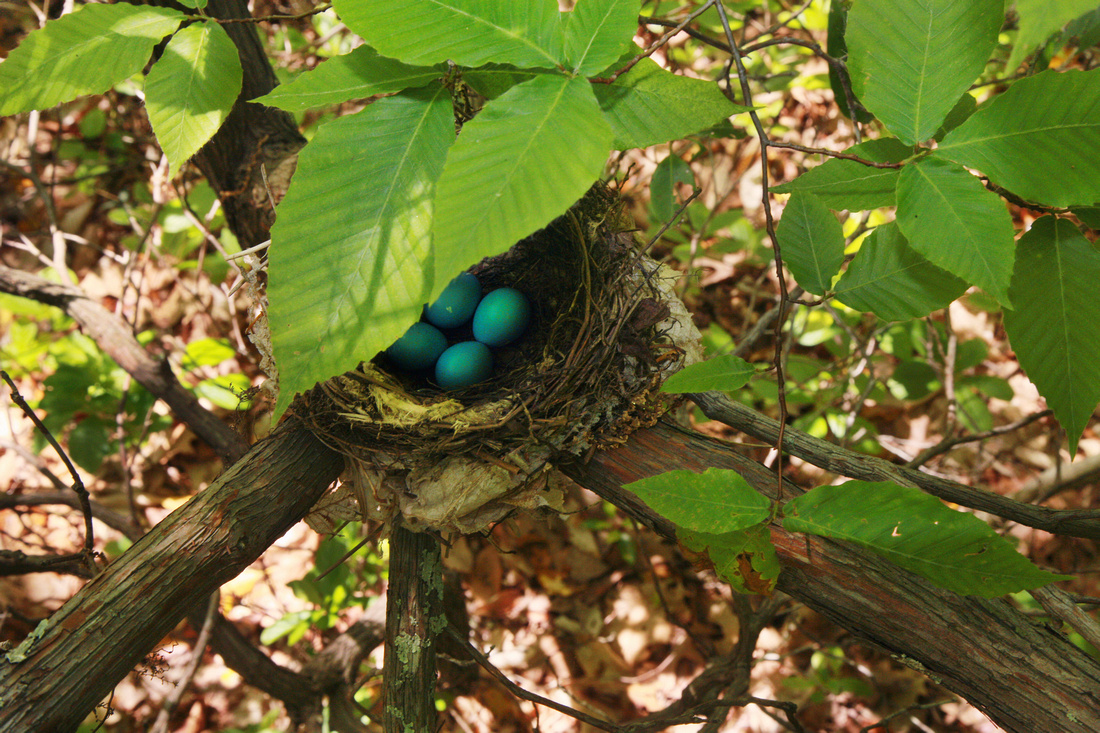

A few days later, my streak was confirmed. An open gate in Nehantic State Forest, one that is normally closed, got me to stop and investigate. Just beyond the gate a bird was singing like the proverbial fat lady (Viking helmet and all) from the edge of a clearing. The song didn't register at first, but I should not have been surprised to find that it was an Indigo Bunting.
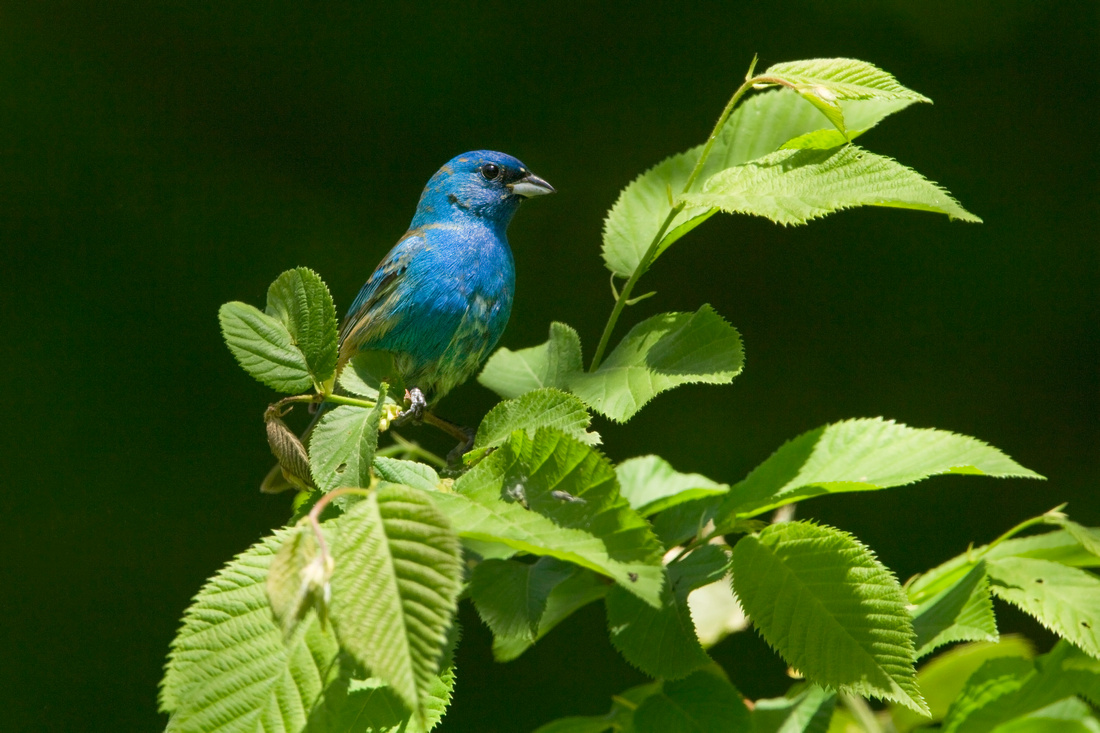

The blue streak was not powerful enough to overcome my uncanny propensity to find only Indigo Buntings that are in some state of molt, and not the perfect all blue specimens that my colleagues seem to find at exactly the same time.


As the nesting season quickly progressed, the bluebirds fledged their young while I was busy with work. I found a few other nests but only two could be photographed, and they too, turned out to be a disappointment (I'll detail in the next post). The Wood Thrush nests all hatched out and I was able to photograph one of them with the adults feeding their chicks. Then work, weather and family events kept me away for five days and I returned to find the nests all but empty. Two were abandoned and in the third, one almost full sized chick remained, missing only its tail feathers. I set up to photograph it, keeping a safe distance, and saw the adults feeding the other fledged chicks in the surrounding woods. One returned to feed the remaining chick a couple times but seemed to be trying to entice it to leave the nest to get its food. The leaves surrounding the nest had grown to obstruct the once open view, so I gave up and went back to my car. I watched for another half hour and saw the chick hop from the nest and out onto a branch, then flutter away out of sight. Just like that, the nesting season seemed to be over for another year, gone in a blue streak.